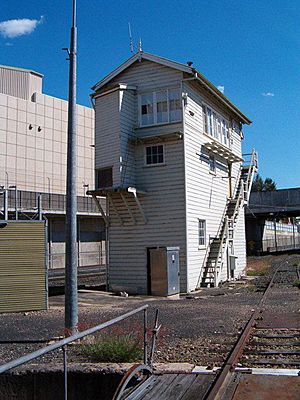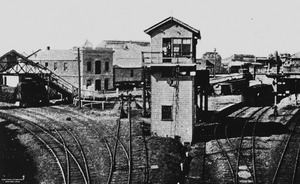Railway Signal Cabin and Turntable, Ipswich facts for kids
Quick facts for kids Railway Signal Cabin and Turntable |
|
|---|---|

Railway Signal Cabin and Turntable
|
|
| Location | Ellenborough Street, Ipswich, City of Ipswich, Queensland, Australia |
| Design period | 1870s - 1890s (late 19th century) |
| Built | 1881 - 1895 |
| Official name: Railway Signal Cabin and Turntable | |
| Type | state heritage (built) |
| Designated | 27 May 2005 |
| Reference no. | 602464 |
| Significant period | 1895-1995 (historical) |
| Significant components | signals, views to, turntable, railway, clock, signal box/signal cabin/switch house/mechanical points (rail), signal mast, machinery/plant/equipment - transport - rail, views from |
| Lua error in Module:Location_map at line 420: attempt to index field 'wikibase' (a nil value). | |
The Railway Signal Cabin and Turntable is a special old building and machine in Ipswich, Australia. It's like a control tower for trains, called a signal box, and a giant spinning platform for locomotives. These important railway parts were built between 1881 and 1895. Today, they are protected as part of Queensland's heritage.
Contents
How Trains Were Controlled
The three-story timber signal cabin in Ipswich once held an amazing machine. This machine, built in 1881 by a company called McKenzie and Holland, helped control train movements. Nearby, there was a large turntable for turning locomotives around. There was also a tall signal, called a semaphore signal, which used arms to tell train drivers what to do. All these parts were super important for the Ipswich railway station.
Queensland's First Railway
Queensland's government really wanted good transport. They needed to connect coastal cities to farming areas. This was a big reason why Queensland became a separate state in 1859.
The very first railway line in Queensland started in Ipswich. It didn't start in the capital, Brisbane, because boats already linked Brisbane and Ipswich. The biggest need was to connect Ipswich to the rich farming lands of the Darling Downs. Work began in 1864. The first part of the line, from Ipswich to Grandchester, opened in 1865. Eventually, the railway reached the Darling Downs and beyond. Ipswich and Brisbane were finally linked by rail in 1875.
The Ipswich Railway Station
Ipswich has had three railway stations, all near the same spot. The first one opened in 1865. When the line extended to Brisbane in 1874, trains had to reverse to get into the station. This was a bit tricky! In 1875, a new track was built. This allowed trains to go straight through Ipswich without reversing.
In 1886, a new station was built in a cutting. It had one main platform and other platforms at the ends. Later, in 1914, big changes were planned. A new 60-foot (18 m) turntable was added in 1921. This replaced an older, smaller one that couldn't handle the new, bigger locomotives.
Keeping Trains Safe
When many trains use the same tracks, it's vital to stop them from crashing. Early safety methods included a "Staff and Ticket" system. A physical token was carried on the train. It had to be passed to the next train going the other way before it could move. Later, an "Electric Staff" system did a similar job electronically.
As more trains ran, safety systems became more complex. Today, "Centralised Train Control" (CTC) is used. This system lets signals and track switches be controlled by a computer from far away.
What is Interlocking?
An "interlocked yard" is a railway area where signals and track switches work together. Signals won't turn green unless the tracks are set correctly. This stops trains from going where they shouldn't. A "mechanical interlocking device" uses rods, bars, and levers. These parts are connected so that track switches cannot be changed in a way that would cause a crash.
McKenzie and Holland were early companies that built these safety systems in Britain. In 1873, they created a new lever design. These levers were easier for the signalman to use.
Ipswich's Special System
In 1880, a Queensland railway official saw McKenzie and Holland's machines. He was very impressed! Queensland ordered the same equipment for Roma Street and Ipswich stations. It arrived in 1881.
Ipswich was only the second station in Queensland to get this advanced system. This shows how important Ipswich was as a railway hub. Most other lines didn't have enough train traffic to need such expensive safety machines.
A contract for the Ipswich signal cabin was quickly started. The interlocking system was finished in 1883. The signal cabin we see today was built later, in 1895. It's unusual because it's three stories high. This was needed so the signalman could see over the bridge and the main railway line.
The Turntable's Role
The other important railway feature still there is the locomotive turntable. This is a spinning platform that turns locomotives around. Ipswich station was unusual because it only had one main track going through it.
In 1921, a new 60-foot (18 m) turntable was added. It replaced an old 41-foot (12 m) one that was too small for modern steam locomotives. An English motor, installed in 1957, helps it spin.
Why Turntables are Rare Now
During the 1960s, diesel-electric locomotives replaced steam trains. Diesel engines can travel in either direction without needing to be turned around. This meant turntables were no longer needed. Many were removed, so they are quite rare now. The Ipswich turntable was used for both steam and diesel trains. It's still used today for turning steam locomotives!
Old Technology, New Systems
Ipswich kept its mechanical interlocking system for a long time. Even after it was removed from Roma Street, Ipswich still used it. Eventually, newer electrical or computerised systems took over. Today, most of the railway network is controlled by computerised "Centralised Traffic Control." These systems can control trains from hundreds of kilometres away!
The signal cabin was stopped from being used in 1995. Now, a large shopping centre has grown up around the signal cabin and turntable. A semaphore signal and its mast are still there, north of the cabin. This is a rare sight on a main railway line in Queensland today.
What It Looks Like
The tall timber signal cabin and the turntable are close together. They are located east of the bridge over the Bremer River. Three sides of them are now surrounded by the walls of a big shopping centre.
The Signal Cabin
The signal cabin is a rectangular timber building with three stories. It has a gabled roof made of corrugated iron. Inside, on the top level, is a large machine with 55 levers. This is the McKenzie and Holland interlocking machine. The top floor has many windows, giving the signalman a great view. The machinery connected to the levers is on the floor below.
An outside staircase on the north side leads to a door on the second level. It also goes up to a narrow landing on the top floor. The cabin even has a special viewing device called a periscope. This helped signalmen see under the nearby road bridges. There's also an old electric clock on the north side. A tall semaphore signal mast stands north of the cabin.
The Turntable
The turntable is located northeast of the signal cabin. It's a standard 60-foot (18 m) spinning platform. It has a pneumatic motor, which used to be powered by the air brake system of the steam locomotive.
Why It's Important
The Railway Signal Cabin and Turntable were added to the Queensland Heritage Register in 2005. This means they are very important to Queensland's history.
- Showing History: The signal cabin and turntable show how railways grew in Queensland. Ipswich was a key railway centre. Building railways was seen as a way to help people settle more areas. It also provided transport for people, goods, and materials between cities and farming regions.
- Rare and Special: The McKenzie and Holland system was installed in 1883. It was one of only two in Queensland, and the other one is gone. Very few signal boxes with these old mechanical systems still exist in Australia. This makes the Ipswich one very rare!
- Great Examples: The elevated signal cabin is the largest and best example of its kind left in Queensland. The turntable and semaphore signal are also rare. The signal machine inside is the second largest ever used in Queensland.
- Clever Technology: The interlocking system, semaphore signal, and turntable were very advanced for their time. They were vital for keeping the railway safe. The signal cabin was designed perfectly. It was high up with lots of windows so the signalman could see everything clearly. The turntable is still working and in its original spot. The McKenzie and Holland machine was top-notch technology. It made train travel much safer!


